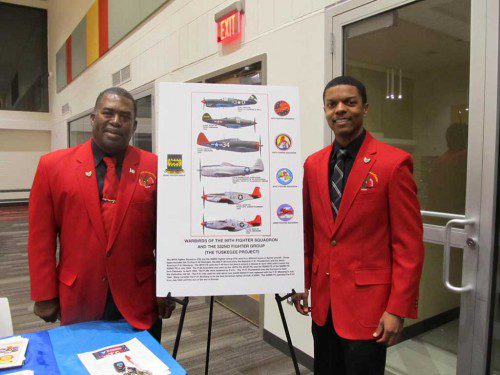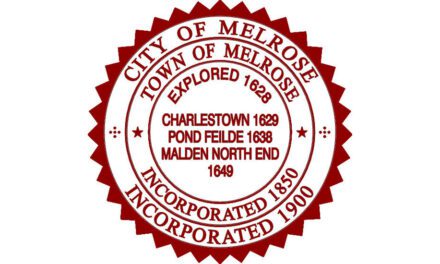Published in the November 11, 2016 edition

TUSKEGEE AIRMEN Galen Williams (left) and Yemoni Huguely are shown standing next to a poster describing the aircraft flown during World War II.
By GAIL LOWE
MELROSE — If there was one message 90-year-old Tuskegee Airman Dr. Harold May wanted to get across while speaking to an audience of approximately 200 people gathered in the brand new Learning Commons at the high school on Monday night, Nov. 7, it was this:
“Our society is bitterly divided. It used to be on race. Now it’s on multiple levels. One thing we have in common is that we’re all Americans, and we are all members of the human race. We are one family,” he said, adding that the days we are living in now are unlike any other days.
“The world has gone crazy. Our challenge is the integration of society,” he said.
Dr. May spoke these words toward the close of his talk on his experience of belonging to the all-African American Army Air Corps program formed prior to World War II.
He said that as a boy he always wanted to fly and built model airplanes. He also made a kite with the help of his two brothers.
“The kite didn’t fly,” he joked.
But eventually, Dr. May did. He said that when he left Fort Devens in Ayer, Mass. to go to Biloxi, Miss. for air training, he crossed the Ohio River on a train and then headed south.
“I had never experienced segregation before, but the deeper south we got the more I saw it,” he said. When he arrived in Biloxi, he knew he was “home.”
“It was where I wanted to be,” May said.
Throughout the history of the United States, African Americans have participated in every armed conflict. But around the time of World War II the law was different. Lynchings were common throughout some states and Jim Crow laws denied Americans of color equal rights and equal protection. Having defended America in the past, African Americans wanted the opportunity to join the Army Air Corps but were denied.
Then, in April 1939 Congress passed a law that authorized the Civilian Pilot Training Program. Soon after, six black colleges and universities were allowed to participate in the program. Even so, African Americans were still not entered in the Army Air Corps. A lawsuit was filed in 1940 by a student from Howard University for admission and as a result, a separate training program was established at Tuskegee (Alabama) Institute. In March 1984, the 99th Fighter Squadron was formed.
During World War II, the Tuskegee Airmen participated in major campaigns in Italy and Germany and were soon requested as escorts by white bomber pilots. The Airmen flew more than 2,000 missions, were well decorated and had aviation records far superior to other groups of flying squadrons during the war.
The success of the unit, including three Distinguished Unit Citations, one Silver Star, 96 Distinguished Flying Crosses, 14 Bronze Stars and eight Purple Hearts, was instrumental in paving the way for the desegregation of the United States military in 1948.
At the time, there were between 15,000 and 16,000 airmen. Of that number, only 18 are still alive.
Dr. May, one of those remaining, was one of four guest speakers who came to the high school to talk about the history and legacy of the Tuskegee Airmen. The military group was comprised of pilots, navigators, bombardiers, maintenance and support staff, instructors and other personnel who were part of the “Tuskegee Experiment.” Before Dr. May left the stage, Melrose Mayor Robert Dolan handed him the Key to the City.
The 90-minute program opened with a welcome from Melrose High School Interim Principal Jason Merrill, presentation of the Color Guard by Boy Scouts Troop 615 and Cub Scouts Pack 615 and the Pledge of Allegiance led by Girl Scouts Troop 65419.
Evynand Akombi, a member of the Class of 2018 and the Melrose Veterans Memory Project, sang the National Anthem.
Opening remarks were delivered by Lt. Col. Robert E. Driscoll Jr., a Melrose firefighter, chairman of the Melrose Veterans Advisory Board and member of the Massachusetts Air National Guard.
During his short talk, Driscoll presented several facts about the Tuskegee Airmen: Air crews shot down three German jets in one day, which was unheard of; Eleanor Roosevelt helped get the airmen off the ground and three airmen went on to become generals.
“These men fought two enemies. The enemies were overseas and here at home,” he said, referring to the discrimination and segregation the airmen faced on American soil. “The true definition of a hero is a Tuskegee Airman.”
During his brief comments, Mayor Dolan said that in 2006 the budget for assisting returning veterans in Melrose was $25,000. “That amount has grown to half a million dollars today.”
The Melrose Veterans Memory Project, established by Dolan in 2005 to provide education, preservation and outreach, documents and preserves Melrose and local history, raises awareness about and appreciation of the role of Melrose residents in history, increases community involvement in recording and preserving local history and supports local organizations in their efforts to honor those who have served.
Galen Williams, president of the Col. Charles E. McGee Chapter of Tuskegee Airmen, Inc., provided a brief history of the organization and Lt. Col. Franklin D. Gaillard II spoke about its legacy.
“These men were defending the country who saw them as second class citizens,” said Gaillard. “At the time, it was unthinkable for blacks to command whites.” Gaillard was referring to the incorrect assumption that black people were unsuitable to defend the country because “they lacked coordination, intelligence and bravery.”
In 1940, said Gaillard, the nation activated the first Tuskegee Airman unit, but when the war ended, discrimination set in again.
“Blacks were here and whites were over there,” he said, using his hands to illustrate his point.
The program also included a video presentation on the Tuskegee Airmen.
A question and answer session moderated by Brigid Alverson concluded the evening.
The program, overseen by history and psychology teacher Lisa Lord, was the first to be held in the new Learning Commons at the high school.
Lord said that the event was a way to help the community and students see that local people played a role in major (historical) events. While there are no specific Tuskegee Airman ties to Melrose, they have definite ties to the Greater Boston area, she said.




